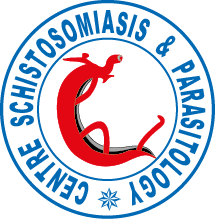Interactions between Schistosoma haematobium and Schistosoma mansoni in humans in north Cameroon
Abstract
Objectives: To analyse the relationships between the frequency of ectopic localizations of Schistosoma haematobium and S. mansoni eggs.
Methods: Studies were conducted in 11 villages in north Cameroon, around Bessoum, a village where an epidemic of bloody diarrhoea caused by S. mansoni occurred in 1997.
Results: The results revealed infection prevalence rates of 70.5% for S. haematobium and 30.8% for S. mansoni. Interestingly, S. mansoni eggs were found in 14.5% of the urine samples and S. haematobium eggs in 3% of the stool samples. These ectopic eliminations of schistosome eggs resulted from sexual interactions between the two species of schistosomes, and from a spill-over of high infection loads. The clinical study showed that the morbidity was lower in individuals with mixed infections and high loads of S. haematobium than in those with S. mansoni infections only, suggesting a possible lowering effect of S. haematobium infection on S. mansoni morbidity.
Discussion: The results obtained in human populations are discussed in relation to the known schistosome interspecific interactions in animal models.
